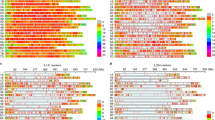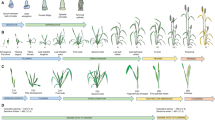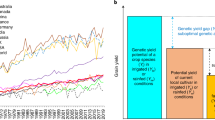Abstract
The world cropping area for wheat exceeds that of any other crop, and high grain yields in intensive wheat cropping systems are essential for global food security. Breeding has raised yields dramatically in high-input production systems; however, selection under optimal growth conditions is widely believed to diminish the adaptive capacity of cultivars to less optimal cropping environments. Here, we demonstrate, in a large-scale study spanning five decades of wheat breeding progress in western Europe, where grain yields are among the highest worldwide, that breeding for high performance in fact enhances cultivar performance not only under optimal production conditions but also in production systems with reduced agrochemical inputs. New cultivars incrementally accumulated genetic variants conferring favourable effects on key yield parameters, disease resistance, nutrient use efficiency, photosynthetic efficiency and grain quality. Combining beneficial, genome-wide haplotypes could help breeders to more efficiently exploit available genetic variation, optimizing future yield potential in more sustainable production systems.
This is a preview of subscription content, access via your institution
Access options
Access Nature and 54 other Nature Portfolio journals
Get Nature+, our best-value online-access subscription
$29.99 / 30 days
cancel any time
Subscribe to this journal
Receive 12 digital issues and online access to articles
$119.00 per year
only $9.92 per issue
Buy this article
- Purchase on Springer Link
- Instant access to full article PDF
Prices may be subject to local taxes which are calculated during checkout



Similar content being viewed by others
Data availability
Seed aliquots from all cultivars used in the study are available from the corresponding authors on request for research purposes. The complete set of adjusted mean trait data from all field locations, years, treatments and replications is available at the online data repository https://zenodo.org/record/1316947 with the digital object identifier number https://doi.org/10.5281/zenodo.1316947. All other data used in the analyses are provided in the Supplementary Information.
Code availability
All codes used in the article are available from the corresponding authors. Please contact K.P.V.-F. via k.vossfels@uq.edu.au for code access and additional information.
References
Foley, J. A. et al. Solutions for a cultivated planet. Nature 478, 337–342 (2011).
Garnett, T. et al. Agriculture. Sustainable intensification in agriculture: premises and policies. Science 341, 33–34 (2013).
Tilman, D., Cassman, K. G., Matson, P. A., Naylor, R. & Polasky, S. Agricultural sustainability and intensive production practices. Nature 418, 671–677 (2002).
Tilman, D., Balzer, C., Hill, J. & Befort, B. L. Global food demand and the sustainable intensification of agriculture. Proc. Natl Acad. Sci. USA 108, 20260–20264 (2011).
Raun, W. R. & Johnson, G. V. Improving nitrogen use efficiency for cereal production. Agron. J. 91, 357–363 (1999).
Sylvester-Bradley, R. & Kindred, D. R. Analysing nitrogen responses of cereals to prioritize routes to the improvement of nitrogen use efficiency. J. Exp. Bot. 60, 1939–1951 (2009).
West, P. C. et al. Leverage points for improving global food security and the environment. Science 345, 325–328 (2014).
van de Wouw, M., van Hintum, T., Kik, C., van Treuren, R. & Visser, B. Genetic diversity trends in twentieth century crop cultivars: a meta analysis. Theor. Appl. Genet. 120, 1241–1252 (2010).
Fu, Y. B. Understanding crop genetic diversity under modern plant breeding. Theor. Appl. Genet. 128, 2131–2142 (2015).
Kahiluoto, H. et al. Decline in climate resilience of European wheat. Proc. Natl Acad. Sci. USA 116, 123–128 (2019).
Lobell, D. B., Schlenker, W. & Costa-Roberts, J. Climate trends and global crop production since 1980. Science 333, 616–620 (2011).
Snowdon, R. J. et al. Reduced response diversity does not negatively impact wheat climate resilience. Proc. Natl Acad. Sci. USA 116, 10623–10624 (2019).
Piepho, H. P. & Möhring, J. Computing heritability and selection response from unbalanced plant breeding trials. Genetics 177, 1881–1888 (2007).
International Convention for the Protection of New Varieties of Plants (International Union for the Protection of New Varieties of Plants, 1991).
Reif, J. C. et al. Wheat genetic diversity trends during domestication and breeding. Theor. Appl. Genet. 110, 859–864 (2005).
Voss-Fels, K. et al. Subgenomic diversity patterns caused by directional selection in bread wheat gene pools. Plant Genome https://doi.org/10.3835/plantgenome2015.03.0013 (2015).
Tanksley, S. D. & McCouch, S. R. Seed banks and molecular maps: unlocking genetic potential from the wild. Science 277, 1063–1066 (1997).
Tripp, R. Biodiversity and modern crop varieties: sharpening the debate. Agric. Hum. Values 13, 48–63 (1996).
Wilkes, G. & Williams, J. T. Current status of crop plant germplasm. Crit. Rev. Plant Sci. 1, 133–181 (1983).
Meuwissen, T. H., Hayes, B. J. & Goddard, M. E. Prediction of total genetic value using genome-wide dense marker maps. Genetics 157, 1819–1829 (2001).
Wheeler, T. & von Braun, J. Climate change impacts on global food security. Science 341, 508–513 (2013).
Watson, J., Zheng, B., Chapman, S. & Chenu, K. Projected impact of future climate on water-stress patterns across the Australian wheatbelt. J. Exp. Bot. 68, 5907–5921 (2017).
Bernardo, R. Prospective targeted recombination and genetic gains for quantitative traits in maize. Plant Genome https://doi.org/10.3835/plantgenome2016.11.0118 (2017).
Muqaddasi, Q. H., Brassac, J., Borner, A., Pillen, K. & Roder, M. S. Genetic architecture of anther extrusion in spring and winter wheat. Front. Plant Sci. 8, 754 (2017).
Wang, S. et al. Characterization of polyploid wheat genomic diversity using a high-density 90,000 single nucleotide polymorphism array. Plant Biotechnol. J. 12, 787–796 (2014).
R Core Team R: A Language and Environment For Statistical Computing (R Foundation for Statistical Computing, 2008); http://www.R-project.org/
Butler, D. asreml: asreml() fits the linear mixed model. R package version 3.0. www.vsni.co.uk (2009).
Lenth, V. R. Least-squares means: the R package lsmeans. J. Stat. Softw. 69, 1–33 (2016).
Bates, D., Maechler, M., Bolker, B. M. & Walker, S. Fitting linear mixed-effects models using lme4. J. Stat. Softw. 67, 1–48 (2015).
Gu, Z. G., Gu, L., Eils, R., Schlesner, M. & Brors, B. circlize implements and enhances circular visualization in R. Bioinformatics 30, 2811–2812 (2014).
Lin, C. S. & Binns, M. R. A superiority measure of cultivar performance for cultivar X location data. Can. J. Plant Sci. 68, 193–198 (1988).
Nei, M. Analysis of gene diversity in subdivided populations. Proc. Natl Acad. Sci. USA 70, 3321–3323 (1973).
Student The probable error of a mean. Biometrika 6, 1–25 (1908).
Endelman, J. B. Ridge regression and other kernels for genomic selection with R package rrBLUP. Plant Genome 4, 250–255 (2011).
Acknowledgements
Funding for this study was provided by the German Federal Ministry of Education and Research (BMBF) grant 031A354. Additional acknowledgements are provided in the Supplementary Information.
Author information
Authors and Affiliations
Contributions
W.F., H.K., F.O., J.L., H.S., R.J.S., A.S., K.P.V.-F. and B.W. conceived the study and the subsequent data analysis. B.W., A.S., K.P.V.-F., C.L., S.N., T.R., T.-W.C., H.Z., S.S., M.F., E.R., B.J.H., M.J.H., M.M.B., A.B., J.L. and H.K. generated and analysed the data. K.P.V.-F., A.S. and R.J.S. wrote the manuscript.
Corresponding authors
Ethics declarations
Competing interests
The authors declare no competing interests.
Additional information
Journal peer review information: Nature Plants thanks M. Reynold, Brande Wulff and other, anonymous, reviewer(s) for their contribution to the peer review of this work.
Publisher’s note: Springer Nature remains neutral with regard to jurisdictional claims in published maps and institutional affiliations.
Supplementary information
Supplementary Information
Supplementary Results, Supplementary Acknowledgements, legends for Supplementary Tables 1–11, legends for Supplementary Data Files 1 and 2, Supplementary Figs. 1–23 and Supplementary References.
Supplementary Tables
Supplementary Tables 1–11.
Supplementary Data 1
Genotype matrix and physical positions of SNP markers.
Supplementary Data 2
Detailed description of genome-wide LD blocks along with their corresponding variances for 15 traits among 191 wheat cultivars measured in three different management intensity levels in the main field trials.
Rights and permissions
About this article
Cite this article
Voss-Fels, K.P., Stahl, A., Wittkop, B. et al. Breeding improves wheat productivity under contrasting agrochemical input levels. Nat. Plants 5, 706–714 (2019). https://doi.org/10.1038/s41477-019-0445-5
Received:
Accepted:
Published:
Issue Date:
DOI: https://doi.org/10.1038/s41477-019-0445-5
This article is cited by
-
Variety mixtures of winter wheat: a general status and national case study
Journal of Plant Diseases and Protection (2024)
-
Breeding progress of nitrogen use efficiency of cereal crops, winter oilseed rape and peas in long-term variety trials
Theoretical and Applied Genetics (2024)
-
Genetic dissection of root architectural plasticity and identification of candidate loci in response to drought stress in bread wheat
BMC Genomic Data (2023)
-
Nitrogen uptake and remobilization from pre- and post-anthesis stages contribute towards grain yield and grain protein concentration in wheat grown in limited nitrogen conditions
CABI Agriculture and Bioscience (2023)
-
Transcriptome profiling at the transition to the reproductive stage uncovers stage and tissue-specific genes in wheat
BMC Plant Biology (2023)



